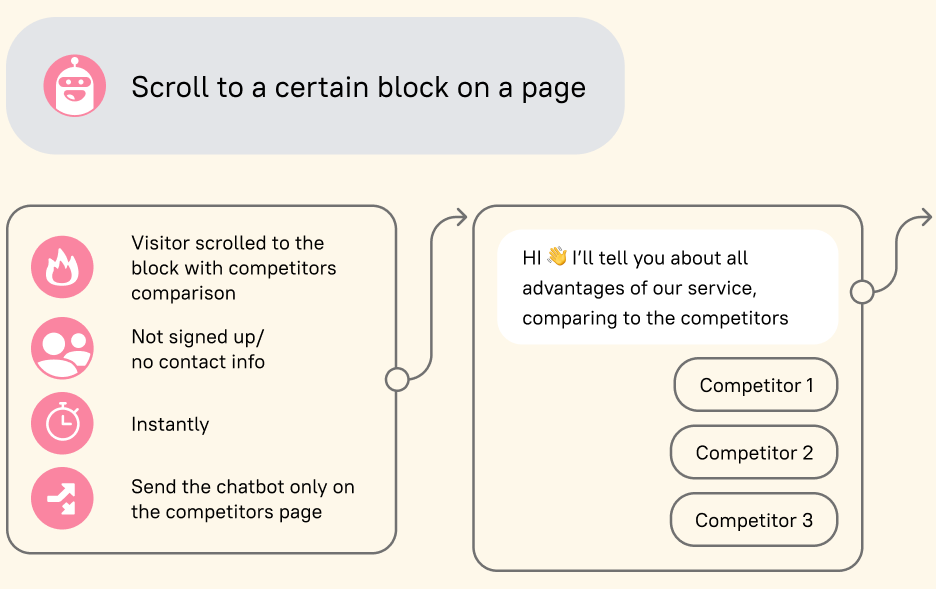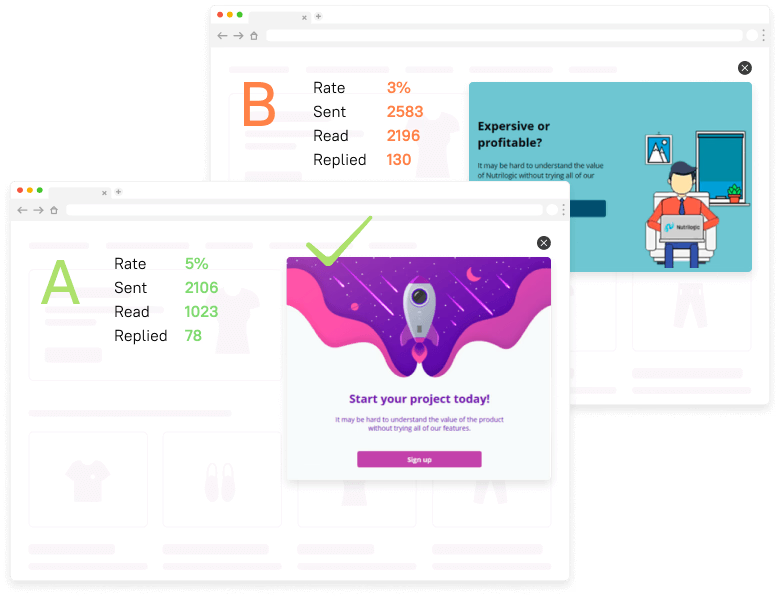Guide to creating Marketing Growth Strategy [6 real examples]
Discover the secrets of rapid business growth from a growth marketing expert. What people to hire, how to manage a team, launch experiments, what tools to use, and a list of proven examples to inspire you.

Part 1: Guide to growth marketing explained by a growth hacker
Part 3: Guide to hacking your product led growth marketing
Part 4: 3 rules and 5 must-have roles when building growth marketing team
Part 5: How to produce growth hypotheses
Part 6: Guide to creating marketing growth strategy [examples]
Part 10: A secret collection of growth marketing tools
Part 12: 25 Growth Marketing Books
In today’s fast-paced business landscape, the importance of having an effective growth strategy cannot be overstated.
With companies constantly vying for attention and market share, it is crucial for businesses to devise a roadmap that not only helps them stand out but also drives sustainable customer led growth.
How?
Welcome to our comprehensive guide on marketing growth strategy, where we delve deep into the realm of growth opportunities. Today, we’ll cover:
- The four major marketing growth strategies derived from the Ansoff Matrix, a renowned process planning tool that has stood the test of time;
- Tested tips and best practices to plan your growth strategy;
- Real-life examples and success stories that proved the power of these strategies in action
By the end of this guide, you will have a clearer understanding of how to approach your marketing efforts in a way that maximizes expansion potential. Get ready to be inspired, educated, and equipped to propel your business to new heights ⛰️
Growth marketing and prerequisites for successful growth
In a nutshell, growth marketing is a blend of creativity, experimentation, and good ol’ data analysis, aimed at customers’ acquisition, engagement and retainment. But it doesn’t stop there! Growth marketing is also about constantly optimizing your strategies to achieve the best possible results.
Now, let’s chat about some of the awesome benefits growth marketing can bring to your business:
- Increased revenue: Who doesn’t love the sound of more money in the bank? By focusing on growth marketing, you’ll be able to attract new customers, upsell to existing ones, and ultimately, boost your bottom line.
- Improved brand awareness: With the right strategy used for marketing campaigns, your brand can become the talk of the town (or, you know, the internet). This means more people will know about your business, and you’ll become their go-to choice when they need the products or services you offer.
- Customer retention: Growth marketing isn’t just about getting new customers; it’s about keeping them too! By continuously delighting your customers and exceeding their expectations, you’ll create loyal fans who keep coming back for more.
- Smarter decision-making: Since growth marketing is all about data and analysis, you’ll be able to make informed decisions that are backed by solid evidence. This means less guesswork and more results!
- Scalability: While hacking growth, you’ll need marketing strategies that can grow with it. Growth marketing is designed to adapt and scale, helping you achieve long-term success.
- Competitive edge: In today’s cutthroat business world, you’ve got to stay ahead of the game. By embracing growth marketing, you’ll gain an edge over your competitors and become the leader in your industry.
Read also:
Growth marketing is your ticket to a thriving, successful business that leaves your competitors in the dust. So, no time to wait, moving on!
The strategy of growth marketing (four types)
It all starts with the Ansoff Matrix. Picture it as a compass that helps you navigate the vast ocean of expansion opportunities for your business. This trusty tool, created by Igor Ansoff back in the 1950s, breaks down growth marketing strategies into four quadrants:
- Market Penetration
- Market Development
- Product Development
- Diversification

Let’s explore all 4 strategies in marketing, shall we?
Market penetration
Think of this as dancing with the one that brought you. Market Penetration is all about increasing your market share within your existing market. You’ve already got your product and your market, and now it’s time to deepen that relationship. So, it’s a growth strategy employs the existing marketing.
You’ll do this by promoting your product more effectively, sweetening the deal with special offers or discounts, or outshining the competition. It’s like turning up the volume on your favorite song to make sure everyone hears it.
Check out these growth marketing tips for inspo ✨
Market development
Market Development is like taking your tried-and-true product and introducing it to a new crowd.
This could mean entering new geographical territories, targeting different demographics, or finding new ways to reach your customers. It’s like discovering a new dance floor where your product can shine!
Product development
Got an itch for innovation? This growth strategy is all about creating new or improved products for your existing market. Think of it as a chef who’s constantly ready to experiment with new recipes to keep loyal customers coming back for more.
This growth hacking strategy requires research, buildout, and creativity, but it’s an excellent way to keep your business fresh and exciting.
Read also:
Diversification strategy
And finally, what growth strategy combines new markets and new products? Hope you’re feeling adventurous! Diversification is a daring leap into the unknown, where you create new products for new markets. Sticking to the dance metaphor, imagine you’ve been a master of salsa dancing for years, and now you decide to learn tango and bring it to a whole new audience.
It can be risky. But when done right, it can open up a world of possibilities and set your business up for long-term success.
The Ansoff Matrix is your trusty guide to four growth strategies in marketing. Now it’s up to you to choose the path that suits your business best and start your journey towards growth and prosperity.
How to create a successful growth model strategy
Once you made up your mind on the destination, it’s time to plan the route. Let’s take a look at the points you need to include in your growth hacking canvas.
1. Set clear goals 🎯
Start by defining what you want to achieve with your strategy of growth marketing. Are you aiming for more sales, increased brand awareness, or better customer retention and churn prevention? Be specific and take measures so you can track your progress and achieve the set goals. You might want to check commonly used frameworks like OKR, or metrics like LTV to get your ideas going.
2. Know your audience 👥
To build winning growth model for market expansion, you’ve got to understand your target audience inside and out. How focused are you really on your clients / customers? Do they use Google or other search engine? Do they have life insurance, car insurance, etc? What brand of cereal they prefer? Those points are just examples and might not be important for your particular growth strategy, but serious now: research the customers’ demographics, preferences, and pain points. The more product metrics framework KPIs you know, the better you can tailor your marketing efforts to resonate with them, the more effective your growth strategy that focuses on customer relationship building and fostering loyalty would be. User tracking can come in handy when you need to know as much as possible about your audience.
3. Analyze the competition 🔍
Keep an eye on what your competitors are doing. What marketing strategies for growth are they using, and what growth hacking examples can you borrow from them? How can you modify their growth strategy so that it helps you elevate your processes? By staying in the loop, you can find ways to differentiate your business and outshine the competition.
4. Choose the right channels 📡
Not all content marketing channels are created equal. Identify the platforms where your target audience spends their time and focus your efforts there: place the ads, track the customer journey, analyze their preferences, etc. This way, you’ll make the most out of your resources and get the best bang for your buck. There are social media growth hacking tools that can help you power up your cross-channel marketing campaigns.
5. Test and optimize 🧪
Embrace the spirit of experimentation! Test different approaches, analyze the results, and tweak your growth strategies in marketing accordingly to reach the right customers. If your hypothesis fail — embrace the process and experiment some more 😉 Remember, success is the product of constant improvement and adaptation.
18 business growth experts you should follow this year

What are Growth Loops? How It Can Scale Your Company

Product Led Growth Marketing: hack your product growth

6. Monitor your progress 📊
Keep track of your marketing campaigns and how well they’re performing. Use data and analytics to identify trends and gain insights. These metrics will help you make smarter decisions and fine-tune your strategies for better results and revenue, and successful growth.
7. Stay flexible 🧘
In the ever-changing world of marketing, you’ve got to be ready to adapt. Be open to new ideas, trends, and technologies, and don’t be afraid to pivot your growth market strategy if something isn’t working.
For more inspo, sign up for a growth marketing newsletter.
8. Collaborate and learn 🤝
Surround yourself with a team of experts, and don’t be shy about asking for advice or feedback. Speaking of experts, don’t forget about other departments of your business and bring their expertise in as well: for example, sales and marketing teams’ collaboration can lead to impressive results. The more you learn from others, the stronger your digital expansion game will be!
Here’s a growth strategy template you can use to cover the main points of your plan:
Thanks! Here’s your copy of the growth strategy template

Growth marketing strategy examples
Alright, let’s dive into some real-life examples from big-name companies that have nailed it.
Apple
Choosing among 4 major growth strategies marketing, Apple settled down on Product Development. And their game is strong! They’ve been consistently innovating and releasing new products that keep customers coming back for more.
Remember when the iPhone first hit the scene? It changed the game forever and set the stage for an entire ecosystem of Apple products, like iPads, Apple Watches, and AirPods.
Amazon
Talk about the risky game of diversification! Amazon started as an online bookstore but quickly expanded into selling, well, pretty much everything. Their growth hacking marketing strategies didn’t stop there, though. They ventured into new markets, like Amazon Web Services (AWS), which became a major player in cloud computing. And let’s not forget their smart home devices, like Alexa. Amazon’s growth is a masterclass in bold, strategic moves, and the cost is justified.
Netflix
Netflix began as a DVD rental service but saw the potential in streaming video content. They transitioned to a subscription-based streaming service, dominating the market and changing the way we consume entertainment.
Their Market Development strategy didn’t end there, as they expanded globally, tailoring their content to different regions and cultures.

Get your free example of growth marketing playbook with 40+ templates for successful experiments
Coca-Cola
Coca-Cola is a fantastic example of Market Penetration. They’ve built a strong brand identity and have been consistent in their marketing efforts, making them one of the most recognizable brands in the world. Top-notch marketing strategy for sales growth!
Through creative advertising campaigns, sponsorships, and collaborations, they’ve managed to make their presence felt in almost every corner of the globe.
Tesla
Tesla has taken the automobile industry by storm with its innovative electric cars. Their Product Development and Market Development strategies have made them a leader in the industry.
By focusing on cutting-edge technology, sleek design, and a sustainable future, they’ve managed to create a brand that appeals to a wide range of consumers who are ready to embrace the electric revolution.
Slack
Another great examples of Market Development is Slack’s partnership program. To expand their customer base, they launched a channel partnership program that enables partners to resell Slack to their own customers. This program allowed Slack to tap into new markets and acquire customers that they wouldn’t have been able to reach on their own.
These big-name companies have shown us that with the right marketing growth strategies, anything is possible. Take inspiration from their success stories and boost your growth marketing metrics!
If you need inspo for your growth strategy, we’re ready to help 👇
Best marketing growth strategy hacks and tips
Now, let’s talk about some of the best tips and SaaS growth hacks to power up your upturn. No matter which of four strategies you’ll choose, these hacks will help you engage with your customers, drive conversions, and skyrocket your growth.
Remember that communication is the key to success!
Read also: A secret collection of growth marketing services Dashly team uses daily
Leverage chatbots
Chatbots are like having a friendly assistant available 24/7 to:
- Capture and qualify leads;
- Deal with FAQs and provide round-the-clock support;
- Guide users to targeted actions and increase your conversions.
By automating routine customer interactions, you’ll have more time to brainstorm new growth hypotheses and iterate your brand strategy.
Don’t use chatbots because they’re complicated to set up and not effective? We’ll prove otherwise!
Personalize triggered emails and marketing campaigns
Triggered emails are a fantastic way to keep in touch with your customers and keep your interactions consistent.
Here’s a great example of digital marketing strategy for business growth from Freedom24, Dashly’s FinTech customer 👉
They test a growth hypothesis with various triggered emails celebrating each benchmark on the customer journey and encouraging users to move forward:
- Top their accounts;
- Start investing;
- Try out the best practices etc.
As a result, their user engagement got up to more than 50% — just thanks to email campaigns!

Personalize your triggered emails based on user behavior, preferences, and interests to make them feel special and increase the chances of them taking action. User behavior tracking will help you with it.
Use pop-ups wisely
Love ’em or hate ’em, pop-ups can be super effective when done right. Let your growth marketing team to use them to capture leads, promote special offers, or encourage social sharing. Just be sure not to overdo it — you don’t want to annoy your visitors.
Here’s a great example of the “special occasion” pop-up. Mofy.life launched a special offer on Black Friday to extend their lead base and retain customers at the same time.
The pop-up resulted in a 65% conversion to leaving contact. In general, the sequence used in this case helped the company gain about 10% of the overall revenue, according to Google Analytics.

And if you need inspo for your future experiments, check out our growth marketing playbook with over 40 ideas from Dashly and our customers:
Let’s finish with a few general marketing strategies for business growth with a few examples 👇
Create viral content
Producing share-worthy content can help your brand go viral and reach new audiences. Invest in creating high-quality, engaging content that resonates with your target audience, and encourage them to share it with their networks.
We opt for content marketing!
HubSpot’s Inbound Marketing Strategy
When it comes to inbound marketing, HubSpot is a true pioneer. Instead of interrupting potential customers with annoying ads or cold calls, HubSpot decided to create valuable content that would attract potential customers to their website. They started blogging consistently, publishing eBooks, and creating webinars that people could sign up for.
This approach not only helped them generate leads and close deals but also established HubSpot as a thought leader in the industry.
Optimize for SEO
Ranking high on search engines is a must for organic growth marketing strategy. Focus on optimizing your website for relevant keywords, improve site speed, and create valuable content that search engines and users will love.
Read also: 25 Growth Marketing Books to Skyrocket Success
Collaborate with influencers
Partnering with influencers can help you tap into new markets and boost your credibility. Identify influencers in your niche and collaborate on campaigns, product reviews, or social media takeovers.
A/B testing
Never settle for “good enough.” Test different elements of your marketing efforts (like headlines, calls-to-action, or designs) to find out what works best and optimize for maximum results. The testing results can help you find the right approach to increasing your conversion rate, optimizing your future campaigns and long-term goals.
There are plenty of growth marketing tools that offer the A/B testing feature.

Offer a referral program
Encourage your existing customers to spread the word by rewarding them with special offers, discounts, or exclusive content. A good referral program can turn your customers into loyal brand ambassadors.
Dropbox’s Referral Program
Dropbox is another SaaS company that is known for its efficient marketing strategy growth. One of their most successful strategies is their referral program. They offer both the referrer and the referred person additional storage space for free if the referred person signs up for Dropbox. This program incentivizes current customers to invite their friends and family to try Dropbox, ultimately leading to more sign-ups and revenue.
These growth hacking tips, combined with conversational marketing tools, can help you create a winning formula for your business’s growth.
The bottom line
Developing a growth strategy is a complicated and, frankly, never-ending process, crucial for any business that wants to stay ahead of the competition and achieve success. By following these steps and continually analyzing and adjusting your approach based on data and market trends, you can create a solid foundation for sustainable growth and customer acquisition. Remember, marketing is not a one-time effort but rather a continuous process of experimentation and optimization. With the right mindset, tools, and resources, you can create a marketing strategy that takes your business to new heights.
Once you made up your mind on the direction, it’s time to experiment! 👩🔬
Test growth hypotheses quickly and without developers with Dashly

Let’s take your business to new heights and leave the competition in the dust together!
FAQ
What is growth marketing?
Growth marketing is a data-driven approach to marketing that focuses on experimentation and optimization with the goal of driving rapid and sustainable growth for a business.
It involves a combination of different marketing strategies including acquisition, retention, and revenue optimization, and usually entails using data, analytics, and testing to implement and refine campaigns that drive growth and increase customer lifetime value.
Read also: RevOps vs Sales Ops.
What are the four basic categories of marketing growth strategies?
Four major growth strategies marketers typically utilizes are: market penetration, market development, product development, and diversification.
- Market penetration involves increasing sales of existing products to existing customers.
- Market development involves finding new markets for existing products.
- Product development involves creating new products for existing markets.
- Diversification involves creating new products for new markets.
What are some key considerations when developing a growth strategy?
It’s important to consider:
- your business goals,
- target audience,
- competition,
- available resources
It’s also essential to have a deep understanding of your market and to conduct regular data analysis to inform and optimize your approach. Learn to conduct researches, experiment on new campaigns: remember that continuous adaptation at every stage is also critical to achieving sustained growth strategy.
How can data analysis help a improve a marketing strategy?
Proper data analysis can provide insights into user behavior, identifying trends and patterns in customer journey, and pinpointing areas of improvement. By analyzing data, marketers can make informed decisions about target audience and communication channels. This allows businesses to create more personalized and effective email marketing campaigns (or any socials, for that matter) that resonate with their ideal customers, ultimately leading to increased sales and customer loyalty to the brand.
What are some common pitfalls to avoid when implementing a chosen strategy?
The process can be rocky and risky. When in pursuit of the revenue, try to avoid the following:
- setting unrealistic goals,
- failing to align the strategy with broader business objectives,
- relying on a single marketing channel or tactic,
- neglecting existing customer base in favor of acquiring new customers — retaining customers can be just as important as acquisition of new leads.
By sidestepping these pitfalls and remaining flexible and adaptable, you can create a solid foundation for sustained marketing growth.
Read also:
- Deep dive into growth marketing analytics with Dashly experts
- 22 SaaS growth hack Facebook tactics to boost your business
- B2B growth marketing: accelerating business success
- Demand Generation vs Growth Marketing: Where to focus?
- Growth marketing vs performance marketing: What to choose for your business
- Skyrocket your company revenue with a complete guide to RevOps Revenue Operations
- Growth marketing case studies: 12 stories with detailed tactics and numbers achieved
- RevOps best practices: 13 tactics to implement this year
- Growth marketing framework: Battle-tested insights from Dashly experts


![Build Ideal Customer Profile Like a Pro Even If You’re Not [3 Templates]](https://www.dashly.io/blog/wp-content/uploads/2021/03/ideal-customer-profile-4-720x308.jpg)



![25 growth hacking books [recommended by Dashly growth hackers]](https://www.dashly.io/blog/wp-content/uploads/2023/05/Growth-Hacking-Books-720x317.png)





